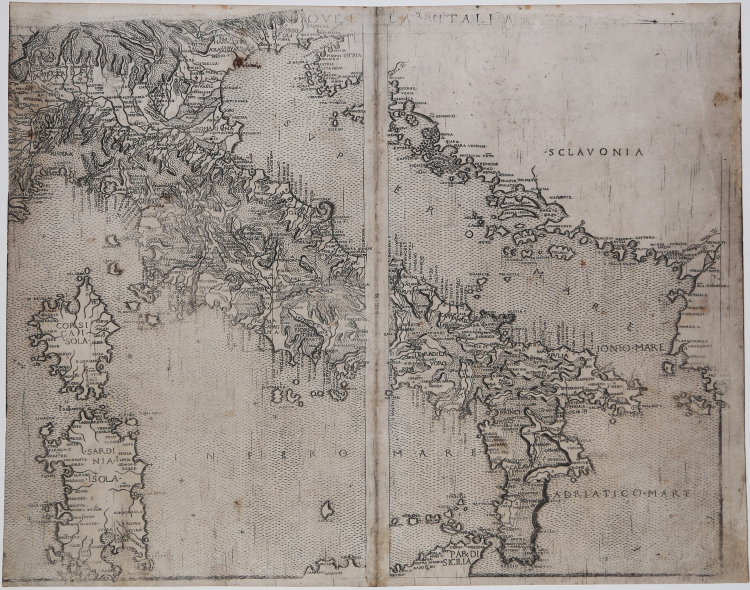



| Reference: | S33972 |
| Author | Francesco Rosselli |
| Year: | 1482 ca. |
| Zone: | Italy |
| Printed: | Florence |
| Measures: | 515 x 400 mm |


| Reference: | S33972 |
| Author | Francesco Rosselli |
| Year: | 1482 ca. |
| Zone: | Italy |
| Printed: | Florence |
| Measures: | 515 x 400 mm |
- THE FIRST MODERN MAP of ITALY, ascribed to FRANCESCO ROSSELLI -
This is the first modern map of Italy, showing the peninsula as it was during the Renaissance.
The map was published in the Francesco Berlighieri's metrical rhyming paraphrase of Ptolemy's Geography. Berlinghieri's text is a "terza rima" adaption of Ptolemy's Cosmographia, augmented by contemporary writers. Although not considered to be an edition of Ptolemy, these are the only examples of Ptolemy's maps printed on the original Ptolemaic projection of equidistant parallels and meridians, and the first to provide gazetteers for the individual maps.
Although undated, external evidence shows that Berlinghieri's edition of Ptolemy's atlas text was completed and published in 1482.
The atlas is the first to include 'modern' maps in addition to the 27 traditional Ptolemaic ones. The four new maps, based on more recent sources, are 'Hispania Novella', 'Gallia Novella', 'Novella Italia' and 'Palestina Moderna', respectively modern Spain, France, Italy and Palestine.
They are based on on those of the Florentie miniaturist Pietro del Massaio of Florence (c.1420–1480) which are found in three manuscripts of Ptolemy by Hugo de Comminellis .
The maps are unsigned. As early as 1938 Arthur M. Hind, Keeper of Prints and Drawings at the British Museum, hinted that the engravings might have been made by Francesco Rosselli (1448-before 1527), the principal engraver in Florence in the 1480s and 1490s.
Of Berlinghieri’s work there is in the Vatican Library a finely decorated manuscript, made for presentation to Federigo, but in the event (because of his death) presented to his son Guidobaldo. In the Braidense in Milan is another finely decorated manuscript, this time made for a Medici wedding, that of Lorenzo de Medici. The text of the two manuscripts shows little variation, but the maps are not the same.
The printed atlas, was published only once, and about 80 examples are known.
These examples, all wirh the same 31 maps, are different for the title: in some example, on the recto of the first page, is "Geographia di Francesco Berlinghieri fiorentino in terza rima et in lingua toscana distincta con le sue tavole in varii siti et provincie secondo la Geographia et distinctione delle tavole di Ptolomeo. Cum gratia et Privilegio" in others, on the verso of the first oage is written "In questo volume si contengono septe giornate della Geographia di Francesco Berlinghieri fiorentino allo Illustrissimo Federigo duca durbino"; in some examples there is the colophon "Impresso in Firenze per Nicolo Todescho et emendato con somma diligentia dallo autore".
These new maps are on the original rectangular projection ; latitude and longitude are not indicated in any way, nor have they scales. Their outlines are clearly derived from the Laurenziana codex or a very close source. The influence of the marine charts is clearly visible in the style of the coastlines, with numerous semi-circular bays and conspicuous headlands. The representation of relief is also very similar to the Ptolemy's Laurenziana manuscript.
Copper engraving, printed on contemporary laid paper, left margin trimmed affectiing a small part of the upper image, centrefold reinforced, otherwise in very good condition.
Mostly of the maps by Berlinghieri seen in the public libraries are trimmed in the platemark.
A nice example of this masterpiece.
Borri, 6 (Rarity: 10 = highest rarity).
|
Suzanne Boorsch, The Case for Francesco Rosselli
as the Engraver of Berlinghieri’s Geographia, in
“Imago Mundi” n. 56, Londra 2004; Borri, 6; Nordenskiöld, 198; R. Almagià, Monumenta Italiae cartographica, Firenze 1929, pp. 9-10.
|
Francesco Rosselli
|
Suzanne Boorsch, The Case for Francesco Rosselli
as the Engraver of Berlinghieri’s Geographia, in
“Imago Mundi” n. 56, Londra 2004; Borri, 6; Nordenskiöld, 198; R. Almagià, Monumenta Italiae cartographica, Firenze 1929, pp. 9-10.
|
Francesco Rosselli